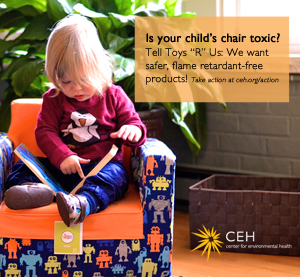You know those sweet moments when your children, or in my case nieces, are curled up reading a book? Or even better when they read out loud to you with their sweet little voices?
It’s moments like those that I continue to fight to protect children’s health from toxic chemicals.
Our partners at the Center for Environmental Health recently revealed that children’s foam furniture contains harmful chemicals.
We’ve known for a while that many couches in the U.S. contain toxic flame retardants, which do very little to slow the spread of fire and have been linked to a variety of health concerns like cancer, hormone-disruption, and harm to the developing brain. What’s worse is many of these chemicals are persistent, meaning they stay in our bodies and the environment.
CEH had one of the leading flame-retardant researchers, Dr. Heather Stapleton (you may remember her from the July 2012 Senate Hearing), test children’s furniture for flame retardants.
The results:
- They tested 42 pieces of children’s furniture containing polyurethane foam. Many of the products had cartoon characters like Disney princesses, Marvel comics, Sesame Street and more.
- They were purchased at major retailers: Babies “R” Us, Toys “R” Us, Walmart, Kmart, Target, Buybuy Baby, and others.
- The samples were collected from 13 states and 3 from Canada.
- They found four different types of toxic flame retardants: Firemaster 550, TCCP, TDCCP, and butylated triphenyl phosphate (I didn’t like chemistry class either).
- 38 of the 42 products tested had flame retardants.
Read the full report here.
Toxic flame retardants, for which there are many, are a widely studied class of chemicals. The health effects of the flame retardants found in CEH’s study range from: hormone disruption, obesity, genetic damage, cancer, decreased fertility, and abnormal menstrual cycles.
Our primary route of exposure to these chemicals is through household dust. The chemicals migrate out of the furniture into dust, and end up on our hands and skin.
Why are toxic chemicals allowed in children’s products?
- Our federal law intended to regulate toxic chemicals — doesn’t. Passed in 1976 the Toxic Substances Control Act is widely regarded as a failure and allows toxic chemicals to end up in our products, homes, workplaces, communities and environment.
- California laws have required the use of flame retardant chemicals (under TB117) in couches and other polyurethane foam products like children’s furniture.
- As of January 2014, manufacturers will no longer be required to use flame retardant chemicals in couches and children’s furniture, but it doesn’t mean that they will stop. When buying new furniture ask manufacturers if they use flame retardants.
- Retailers and manufacturers aren’t minding the store. Earlier this year we launched a campaign to ask the nation’s top ten retailers to take action on toxic chemicals like flame retardants.
What you can do:
- Tell Congress we need STRONG laws on toxic chemicals.
- Ask the nation’s top ten retailers to take action on toxic chemicals.
- Avoid buying products that contain polyurethane foam. Safer substitutes include wool, polyester, down or cotton.
- Visit CEH’s website for safer alternatives to children’s furniture like wood and canvass chairs.
- Wash your hands and your children’s frequently, before you eat, after dusting, handling dryer lint and vacuum bags.
- Use a vacuum with a HEPA filter.
- Check out CEH’s website for an updated list of which products do not contain toxic flame retardants.
Whether or not you have children, this affects all of us.
Toxic chemicals shouldn’t be in our couches or children’s furniture. Help spread the word. Our movement is rapidly growing and we need your voice to send Congress a message that we want strong laws on toxic chemicals.




